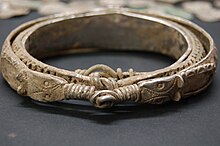Silverdale Hoard
[1] The items were deposited together in and under a lead container buried about 16 inches (41 cm) underground which was found in a field by a metal detectorist.
It is believed to date to around AD 900, a time of intense conflict between the Anglo-Saxons and the Danish settlers of northern England.
The hoard was discovered by local metal detectorist Darren Webster after 20 minutes of detecting in a field that he had previously searched several times before without finding anything more significant than a Tudor half-groat.
His wife had given him the detector the previous Christmas as a present, and he was taking a short time off to try his luck before heading to work.
The reverse has the letters DNS (Dominus) REX (King) arranged in the form of a cross, indicating a Christian affiliation.
[3] Its design is related to coins issued by the Northumbrian Viking rulers Sigfroðr and Knútr,[6] who may have ruled the kingdom jointly between 895 and 905.
[2] The British Museum displayed a selection of the finds from mid-December 2011 through to the New Year, in conjunction with the launch of the annual reports on the Portable Antiquities Scheme and the Treasure Act 1996.
[10] The independent Treasure Valuation Committee then carried out an evaluation of the hoard's monetary value and a reward was shared between its finder and the landowner.
[17] In February 2020, plans were announced for a bid to the National Lottery Heritage Fund for £96,000 to support a temporary display of the hoard in Silverdale village library,[18] but this did not take place because of COVID-19.







